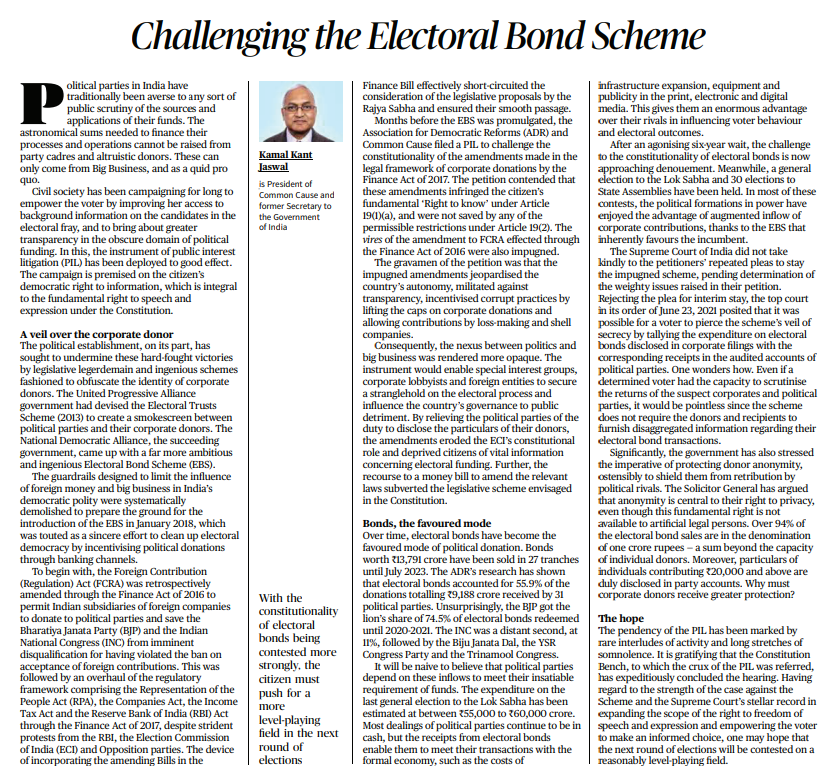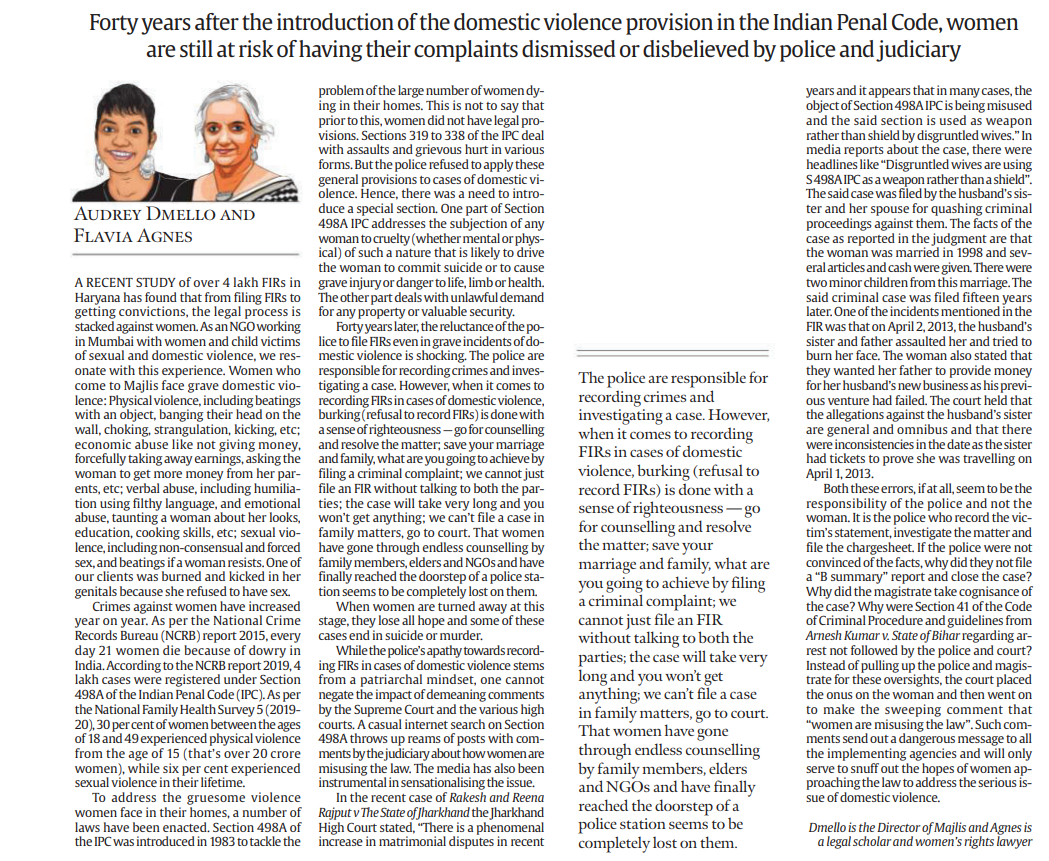The Nexus of Political Funding and Electoral Bonds in India
Introduction:
- Political parties in India historically resist public scrutiny of their funding sources and utilization, often relying on significant contributions from big business.
- Civil society advocates for greater transparency and citizen empowerment through public interest litigation (PIL) to enhance access to information about candidates and political funding.
Legislative Maneuvers and Schemes:
- The political establishment responds with legislative tactics, such as the Electoral Trusts Scheme (2013) and the more ambitious Electoral Bond Scheme (EBS) introduced by the National Democratic Alliance in 2018.
- Amendments to the Foreign Contribution (Regulation) Act (FCRA) and other regulatory frameworks pave the way for increased corporate contributions, raising concerns about transparency and the influence of big business in India’s democracy.
Challenges to Constitutional Amendments:
- Organizations like the Association for Democratic Reforms (ADR) challenge the constitutionality of amendments, asserting that they violate citizens’ fundamental right to information.
- The amendments are criticized for eroding transparency, incentivizing corruption, and creating an opaque link between politics and big business.
Dominance of Electoral Bonds:
- Electoral bonds emerge as the predominant mode of political donation, constituting a significant portion of total contributions.
- The Association for Democratic Reforms’ research reveals that electoral bonds accounted for a substantial portion (55.9%) of the donations received by political parties, with the BJP receiving the majority.
Financial Impact and Political Advantage:
- Despite the immense financial requirements of political campaigns, electoral bonds enable parties to engage with the formal economy, giving them a distinct advantage in infrastructure expansion, equipment acquisition, and media publicity.
- The financial impact of electoral bonds contributes to shaping voter behavior and influencing electoral outcomes.
Legal Challenges and Supreme Court’s Response:
- The legality of electoral bonds faces a constitutional challenge, with the Supreme Court addressing the issue.
- The court, however, rejects pleas for an interim stay on the scheme, emphasizing the possibility for voters to pierce the veil of secrecy by cross-referencing expenditures.
- Critics argue that the lack of disaggregated information in the scheme undermines this approach.
Anonymity and Privacy Concerns:
- The government justifies the need for donor anonymity, citing privacy concerns and protection from political retribution.
- However, questions arise regarding the greater protection afforded to corporate donors compared to individual contributors, as individual details above a certain threshold are already disclosed in party accounts.
Hope for a Level Playing Field:
- Despite a prolonged legal process, there is optimism that the Constitution Bench’s expedited hearing may lead to a more level playing field in future elections.
- The Supreme Court’s history of expanding the right to freedom of speech and expression, coupled with the expectation of empowering voters to make informed choices, raises hopes for positive outcomes.
Conclusion:
The interplay between political funding, electoral bonds, and legal challenges in India underscores the ongoing struggle for transparency, citizen empowerment, and a fair electoral process.
As the legal battle unfolds, the hope remains that future elections will be contested on a reasonably level playing field.
Prescription Conundrum in Indian Healthcare: A Struggle Between Generics and Quality Assurance
Introduction:
The practice of seeking medical advice from non-pharmacists in Indian medical shops is a prevalent phenomenon, raising concerns about the reliability of over-the-counter medical sales.
The editorial sheds light on the dominance of generic medications over branded ones and the implications of the National Medical Council’s (NMC) directive to prescribe only generic names.
Over-the-Counter Sales Dynamics:
In India, individuals often consult non-professional staff at medical shops for advice on medications, bypassing the prescribing doctor’s recommendations.
The editorial emphasizes the significant role played by salespersons in determining which brand of generic medicine is dispensed to patients, creating a unique scenario where the prescriber’s preference is sidelined.
Generic Over Brand:
- The NMC’s directive on prescribing only generic names, motivated by the cost disparity between generic and branded medications, has led to protests.
- The editorial discusses the historical context, citing the 1975 Hathi Committee, which aimed to phase out brand names gradually.
- It challenges the perception that only renowned brands guarantee quality, attributing this belief to the influence of big pharma companies.
Quality Assurance Challenges:
- The editorial delves into the alleged nexus between pharmaceutical companies and doctors, emphasizing the ethical commitment of medical professionals to ensure access to affordable medicines.
- However, it questions the mechanisms in place to guarantee the quality of medications, citing the prevalence of spurious and “not standard quality” medicines in national drug surveys.
Ensuring Medication Quality:
- The editorial advocates for stringent measures to ensure the quality of medicines, including periodic sampling, banning batches that fail quality tests, and taking punitive actions against manufacturers.
- It highlights the Tamil Nadu Medical Services Corporation Limited’s practice of keeping supplied medicines under quarantine until quality tests are cleared as a model worth replicating.
Balancing Generic Prescriptions and Quality Assurance:
- While supporting the idea of generic prescriptions, the article argues for allowing doctors to include the name of the company they trust in terms of medication quality.
- It contends that until the government provides concrete evidence of the standard quality of all medicines, doctors should have this flexibility to maintain patient safety.
Other Healthcare Issues:
- The editorial touches upon broader issues in the healthcare system, such as the low availability rate of essential medicines, the prevalence of non-essential medications, and the need to ban unscientific combinations of drugs.
- It also advocates for monitoring the implementation of policies related to free medicines and diagnostics under Universal Health Care.
Conclusion:
The editorial concludes by highlighting the withdrawal of the NMC’s order on ‘generic prescribing’ following protests from the Indian Medical Association.
It points out the need for comprehensive measures to ensure affordable and quality medicines, emphasizing the importance of maintaining progress towards universal access to affordable generic medicines for all.
Domestic Violence and Legal Challenges Faced by Women in India
Introduction:
The recent study of over 4 lakh FIRs in Haryana sheds light on the systemic challenges faced by women in the legal process, especially in cases of domestic violence. The experiences shared by Majlis, an NGO in Mumbai, resonate with the findings, emphasizing the prevalence of severe forms of violence against women.
Rising Crimes Against Women:
– The National Crime Records Bureau (NCRB) reports indicate a concerning increase in crimes against women, with 21 women daily succumbing to dowry-related issues as of 2015.
– Section 498A of the Indian Penal Code (IPC) was introduced in 1983 to address domestic violence, but recent data (2019) reveals 4 lakh cases registered under this section.
– National Family Health Survey 5 (2019-20) highlights that 30% of women aged 18-49 face physical violence, affecting over 20 crore women, and 6% experience sexual violence in their lifetime.
Legal Framework and Challenges:
– Section 498A IPC was enacted to specifically address domestic violence issues, with one part dealing with cruelty likely to drive a woman to suicide and the other addressing unlawful demands for property.
– Despite the legal provisions, the police exhibit reluctance in filing FIRs in cases of domestic violence, resorting to counseling rather than legal action.
– The police’s patriarchal mindset contributes to the refusal to record FIRs, and demeaning comments by the judiciary further compound the issue.
Judicial Commentary and Media Sensationalism:
– Demeaning comments by the judiciary, as seen in the case of Rakesh and Reena Rajput v The State of Jharkhand, contribute to the perception that women misuse Section 498A.
– The media’s role in sensationalizing such cases further perpetuates the narrative of misuse, creating a hostile environment for women seeking legal redress.
Case Analysis – Rakesh and Reena Rajput v The State of Jharkhand:
– The case exemplifies judicial comments suggesting the misuse of Section 498A, with headlines portraying disgruntled wives using it as a weapon.
– The court’s focus on minor inconsistencies rather than addressing police oversight raises questions about the fairness of the legal process.
– The court places the burden on the woman, making sweeping statements about women misusing the law, which can discourage women from seeking legal recourse.
Conclusion:
The study and experiences presented reveal a troubling pattern where the legal system, from police reluctance to judicial commentary, fails women seeking justice in cases of domestic violence. Addressing these systemic issues is crucial to providing a fair and supportive legal environment for victims.




